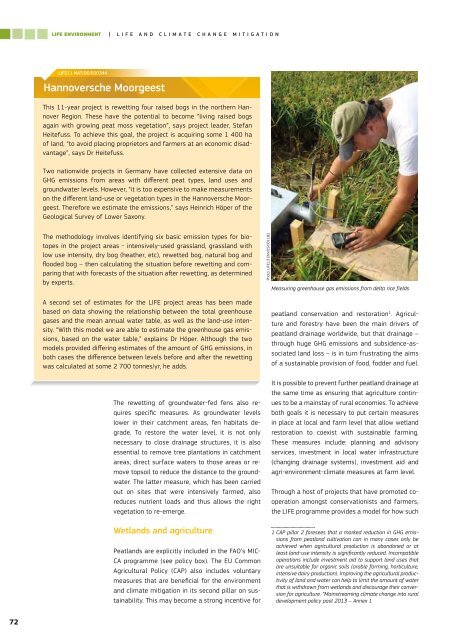You also want an ePaper? Increase the reach of your titles
YUMPU automatically turns print PDFs into web optimized ePapers that Google loves.
LIFE ENVIRONMENT |LIFE and Climate CHANGE mitigationLIFE11 NAT/DE/000344Hannoversche MoorgeestThis 11-year project is rewetting four raised bogs in the northern HannoverRegion. These have the potential to become “living raised bogsagain with growing peat moss vegetation”, says project leader, StefanHeitefuss. To achieve this goal, the project is acquiring some 1 400 haof land, “to avoid placing proprietors and farmers at an economic disadvantage”,says Dr Heitefuss.Two nationwide projects in Germany have collected extensive data onGHG emissions from areas with different peat types, land uses andgroundwater levels. However, “it is too expensive to make measurementson the different land-use or vegetation types in the Hannoversche Moorgeest.Therefore we estimate the emissions,” says Heinrich Höper of theGeological Survey of Lower Saxony.The methodology involves identifying six basic emission types for biotopesin the project areas - intensively-used grassland, grassland withlow use intensity, dry bog (heather, etc), rewetted bog, natural bog andflooded bog – then calculating the situation before rewetting and comparingthat with forecasts of the situation after rewetting, as determinedby experts.A second set of estimates for the LIFE project areas has been madebased on data showing the relationship between the total greenhousegases and the mean annual water table, as well as the land-use intensity.“With this model we are able to estimate the greenhouse gas emissions,based on the water table,” explains Dr Höper. Although the twomodels provided differing estimates of the amount of GHG emissions, inboth cases the difference between levels before and after the rewettingwas calculated at some 2 700 tonnes/yr, he adds.The rewetting of groundwater-fed fens also requiresspecific measures. As groundwater levelslower in their catchment areas, fen habitats degrade.To restore the water level, it is not onlynecessary to close drainage structures, it is alsoessential to remove tree plantations in catchmentareas, direct surface waters to those areas or removetopsoil to reduce the distance to the groundwater.The latter measure, which has been carriedout on sites that were intensively farmed, alsoreduces nutrient loads and thus allows the rightvegetation to re-emerge.Wetlands and agriculturePeatlands are explicitly included in the FAO’s MIC-CA programme (see policy box). The EU CommonAgricultural Policy (CAP) also includes voluntarymeasures that are beneficial for the environmentand climate mitigation in its second pillar on sustainability.This may become a strong incentive forPhoto: LIFE13 ENV/ES/001182Measuring greenhouse gas emissions from delta rice fieldspeatland conservation and restoration 1 . Agricultureand forestry have been the main drivers ofpeatland drainage worldwide, but that drainage –through huge GHG emissions and subsidence-associatedland loss – is in turn frustrating the aimsof a sustainable provision of food, fodder and fuel.It is possible to prevent further peatland drainage atthe same time as ensuring that agriculture continuesto be a mainstay of rural economies. To achieveboth goals it is necessary to put certain measuresin place at local and farm level that allow wetlandrestoration to coexist with sustainable farming.These measures include: planning and advisoryservices, investment in local water infrastructure(changing drainage systems), investment aid andagri-environment-climate measures at farm level.Through a host of projects that have promoted cooperationamongst conservationists and farmers,the LIFE programme provides a model for how such1 CAP pillar 2 foresees that a marked reduction in GHG emissionsfrom peatland cultivation can in many cases only beachieved when agricultural production is abandoned or atleast land-use intensity is significantly reduced. Incompatibleoperations include investment aid to support land uses thatare unsuitable for organic soils (arable farming, horticulture,intensive dairy production). Improving the agricultural productivityof land and water can help to limit the amount of waterthat is withdrawn from wetlands and discourage their conversionfor agriculture. “Mainstreaming climate change into ruraldevelopment policy post 2013 – Annex 172


